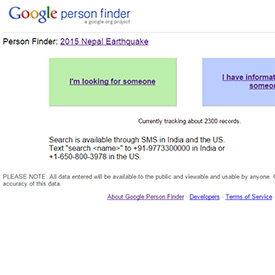Google has officially opened its web-based tool for person Finder in response to the earthquake of strength 7.8, which has reached Nepal this morning and who are looking for information about friends and relatives, have a way to get information about their status.
According to officials, the earthquake hit an area between Kathmandu and Pokhara. The current number of fatalities has so far been around 1,130 people, and more than 1,700 people have been injured as a result of the earthquake – which reduced a number of buildings, temples and other historical monuments in the Nepalese capital.
Google's person Finder -Tool is relatively simple and is also accessed for those who have no access to a computer via mobile devices. If you are on the Internet, all you have to do is pull your page up and specify whether you are looking for a person or have information about a person in the affected area.
If the former, enter the name of a person – or parts of the name of the person – and Google lets them communicate whether it matches someone in your database. In this case, you can choose the specific person who leads you to a miniature profile of sorts that Google has created. Otherwise you can create a new missing person profile yourself.
In this profile, those looking for a person can publish all identifying information that you know about the individual: your name, alternative names, sex, age, house address or helpful descriptions. You can upload a photo or enter one by URL, add links to the other social network profiles of a person and a time to which the person record of the missing person has expired (between one month and one year from the date on which you enter it). You can also enter your own information about the profile and receive notifications if someone publishes other updates about the missing person.
If you have information about one person who wants to know others, you can enter your first and last name on Google's person finder to fill out information for an existing profile. (You can also create a new report for a person who is not yet in the database of the person Finder.)
Recommended by our editors
With the report page you can indicate the status of the person, every message that you search for this person (or others) and the last potential known location of the person. You can specify whether you have physically spoken to the person after the catastrophe and you can also attach a photo. As before, you are also asked to leave your contact information if someone else wants to get in touch with you about the status of the person or your location.
If you are in the area of the earthquake in Nepal, you can probably also use Facebook's “security check” to let others know that you are doing well.
Get our best stories!
What is new now
Register for your daily dose of the latest Tech messages, the best new products and the expert advice from PCMAG editors.
If you click on login, confirm that you are 16+ and agree to our terms of use and data protection regulations.
Thank you for signing up!
Your subscription was confirmed. Keep an eye on your inbox!
About David Murphy
Freelancer

David Murphy got his first real taste of technology journalism when he arrived in PC magazines as an intern in 2005. A three -month appearance turned to six months, six months occasionally freelance tasks, and later he returned to his technical -loving, mostly newer friends in pcmag.com. For further technical delicacies from David Murphy, follow him on Facebook or Twitter (@thedavidmurphy).
Read David's full biography


Comments are closed.